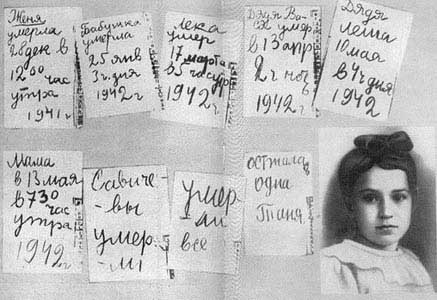
The Siege of Leningrad courtesy http://andrewvanz.blogspot.ca/2013_05_01_archive.html.
1. The Siege of Leningrad, also called the Leningrad Blockade, lasted an agonizing 872 days, from September of 1941 to January of 1944.
2. A total of 414, 148 children and about 1 million adults (mainly women) were evacuated during the Siege to the Volga, Urals, Siberia and Kazakstan.

A Survivor of the Siege of Leningrad courtesy https://02varvara.wordpress.com/2009/01/26/they-endured-and-survived-the-children-of-the-siege-of-leningrad/.
3. A total of 1.2 million civilians perished, many due to starvation, during the Siege.
4. The Soviet Baltic Fleet made over 100,000 missions during the Blockade to save the city.
5. Leningrad was isolated from the rest of the country until an ice road formed over Lake Ladoga, called the "Road of Life" https://en.wikipedia.org/wiki/Road_of_Life

Lake Ladoga, the Road of Life, offers way of escape and transportation route for food for Leningradians courtesy http://www.dw.com/image/17378704_303.jpg,
6. Hitler ordered that the Palaces of the Czar be looted and destroyed. Russians had hastily wallpapered over the famous Amber Room in the St. Catharine Palace. Discovered by the German Army, they disassembled it and brought it to Koenigsber Castle in East Prussia where it went missing in 1944 http://alinefromlinda.blogspot.ca/2011/07/amber-room.html.
7. The economic destruction and loss of life at the Siege of Leningrad was greater than that of both Hiroshima and Nagasaki.
8. The Diary of Leningradian Tanya Savicheva, found later in the war, describes the starvation of each of her family members https://en.wikipedia.org/wiki/Tanya_Savicheva

Tanya Savicheva's Diary courtesy https://commons.wikimedia.org/wiki/File:Tanya_Savicheva_Diary.jpg.
9. Deaths in Leningrad peaked in January and February of 1942 when temperatures dropped to -30 Celsius and food rations to 125 grams of bread per day, half of which was usually sawdust.
10. Adolf Hitler was so convinced that the Wehrmacht would capture Leningrad that he sent out invitations for a celebration at the Russian city's Hotel Astoria. However, the Red Army finally drove the Germans out in January of 1944.
Note: Rob's great Uncle Artur, Oma's brother, who served with the German Army, froze to death at the Gates of Leningrad.
No comments:
Post a Comment